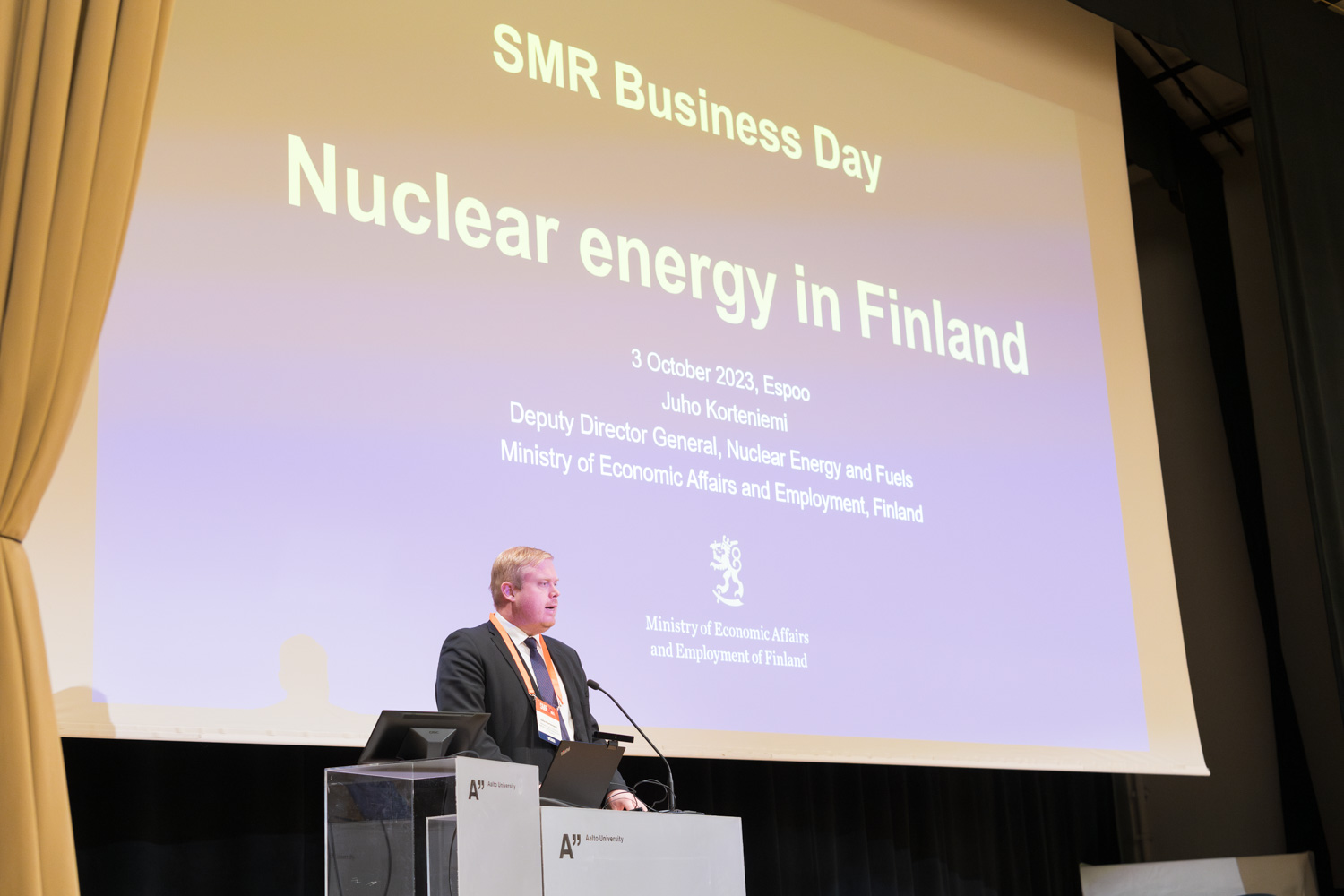
The SMR Business Day 2023 opened with a presentation from the Ministry of Economic Affairs and Employment in Finland held by Juho Korteniemi on the current status of nuclear energy in Finland. Korteniemi highlighted Finland’s promising future in the nuclear field, the country’s expansionary plans and opportunities based on the government’s proactive stance and support towards nuclear energy, the existence of a uniquely strong societal acceptance and trust in the authority and the industry, as well as the ambitions to reach out for regional, EU-wide, and international collaboration, investment and knowledge transfer. It was further pointed out that Finland’s nuclear industry is well known for its reliability, high efficiency and effective waste management.
Efforts are undertaken to continuously improve technology, resilience and public engagement, which is visible exemplarily through the newly launched SAFER2028 project, which ensures ongoing research on nuclear safety and aims at attracting and funding a young and energetic talent pool.
Korteniemi’s speech was followed by a presentation from the OECD Nuclear Energy Agency held by Brent Wilhelm, who introduced the current technology status of SMR designs and addressed what needs to be done to ensure a smooth and ready deployment of SMRs on a wider scale. He stressed that it is not about technology readiness, since the NEA’s publications revealed that a huge variety of SMR designs is already out there, in the process of being licensed, tested and launched in the upcoming years, but instead about a lack in human resources. This view was shared by several other speakers that followed Wilhelm, namely Yves Desbazeille from Nuclear Europe, highlighting a lack of skilled expertise, a talent pool to select from so to speak, as the major bottleneck of future implementations in the nuclear industry, especially the implementation of SMRs.
Several speakers addressed and outlined the manifold benefits of investing in nuclear energy over another energy source, those achieving sustainable development goals, ensuring energy independence and thus reducing vulnerability to external shocks in energy pricing, obtaining a safe, reliable and carbon-free energy baseload, increasing business attractiveness, price competitiveness and market expansion, just to name a few.
The presentations went on by presenting SMR designs from various companies. Ville Tulkki from VTT, Damien Drocourt from Nuward EDF, Eero Vesaoja from Fortum, and Rita Baranwal from Westinghouse gave snapshots of their current SMR design timelines, progress in materializing their projects and future prospects. The speakers highlighted the advantages of SMRs, their multipurpose functionality, utilizing a SMR plant exemplarily for uses beyond electricity such as district and industrial heat, desalination, P2X, hydrogen and fuel production at the same time. Moreover, SMRs were presented to be safer, cheaper in construction and maintenance as well as faster in deployment due to their smaller size and modularity. They become especially attractive for deployment in urban environments, used for district heating and promise a lifespan of 80+ years.
Finally, the NIMBY (“Nuclear in my backyard” as opposed to “Not in my backyard”) panel discussion on societal approval and stakeholder engagement, which welcomed speakers from a variety of Nordic countries, Diana Revjako from Fermi Energia/Estonia, Tommi Nyman from Steady Energy/Finland, John Kickhofel from Norsk Kjernekraft/Norway and Christian Sjölander from Kärnfull Next/Sweden. In their discussion they agreed on the significance of ensuring public trust, understanding for and acceptance of nuclear energy. The industry needs to speak out more with clarity, and to communicate without technical jargon to the public.
They concluded that effective communication, trust building and involvement in education by engaging with universities is vital for public support and continuous progress in the nuclear industry. A view shared also by Timo Okkkonen from Kind Atom and Peter Tuominen from Pragmacon, which stressed that the nuclear energy business needs to be made legible and understandable especially for the ordinary citizen as well as the supplier. Kickhofel pointed out that cross-industry knowledge transfer a mutual learning, exemplary from the oil and gas industry could also be beneficial and they all agreed that the nuclear industry has historically been an effective communicator in a business-to-business environment, not so much yet in business-to-customer communication, which is therefore an essential aspect to improve when it comes to stakeholder engagement.
To conclude, the SMR Business Day in Espoo welcomed a variety of versatile, international players in the nuclear energy industry to discuss the future of nuclear energy, especially its new SMR projects in a Nordic context, but also on a regional and global level. It became apparent that setting out the infrastructure for future SMR projects is a complex undertaking, which will require a lot of effort by many actors. Yet the future of nuclear energy seems promising and noticeable changes in the industry allow for exciting times ahead!
Contributed by
Eileen Staudt
Helsinki, October 4 th , 2023
Eileen is a Master’s degree student at the University of Helsinki, seeking
internships/student part-time opportunities.
